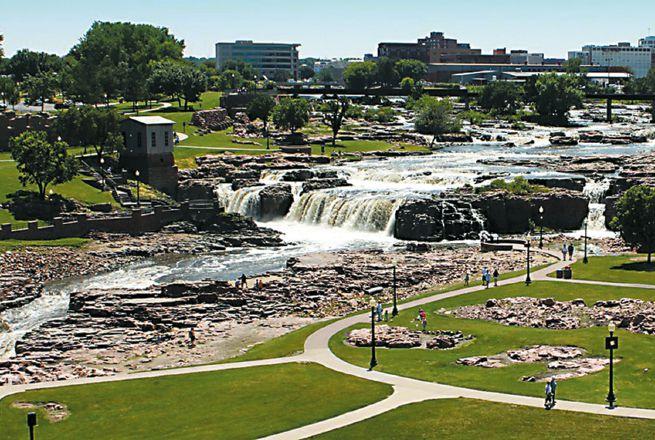
3 minute read
Sioux Falls: Diverse, growing and looking for workers
Editor’s note: Fedgazette, the regional business and economics publication of the Federal Reserve Bank of Minneapolis, profiled Sioux Falls in the publication’s “Spotlight” feature recently.
“Spotlight,” as Fedgazette describes, “is an occasional feature about Ninth District communities in which the Minneapolis Fed has held private meetings with businesses to gauge regional economic conditions.”
A version of the article, abridged for space, is below. The original can be found at the Minneapolis Fed’s website, minneapolisfed.org.
Sioux Falls is the economic nerve center of South Dakota. Residents typically describe their city’s diverse economy as “booming” and “on fire,” and the data bear out that assessment. With just over a quarter of a million residents, the Sioux Falls metro area, which encompasses Minnehaha County and parts of three other counties, is the state’s largest urban area, and one of the fastest growing. Over the past decade, the central city of Sioux Falls has added roughly 3,000 residents each year, city records show.
Commercial and residential contractor vans can be seen everywhere. Construction permits issued for new housing in the city of Sioux Falls have set annual records in recent years; last year, the city permitted over 2,600 single- and multifamily dwellings, a 29 percent increase over the previous record set in 2014.
Sioux Falls’ unemployment rate routinely ranks among the lowest in U.S. metros — it was 2.8 percent in January. “Anyone who wants a job has a job,” said one local business owner.
Sioux Falls has learned well the lesson of not remaining a oneindustry town.
For more than a century, the city has been a key hub for agriculture in eastern South Dakota. The I-29 corridor cuts through rich farmland between Vermillion and Watertown, and two state universities in the region — the University of South Dakota in Vermillion and South Dakota State University in Brookings—have helped to keep the area at the forefront of ag research and production.
But the city’s economy encompasses far more than corn, soybeans and pork. Over the past 40 years, it has broadened to include health care, financial services and computer software, providing a sound base for continued growth.
Financial services came first, in the early 1980s, after the state passed a law that eliminated caps on bank interest rates. Citibank of New York relocated its credit card operations to Sioux Falls, and Wells Fargo, HSBC, TCF Bank and dozens of other financial institutions followed, drawn by low operating costs as well as the freedom to charge higher interest rates. By 2009, roughly 20,000 people worked at financial services firms in the metro area.
About the time it seemed that the local economy would become reliant on financial services, another sector was on the rise: health care. In 2007, First Premier Bank owner T. Denny Sanford donated $400 million to the Sioux Valley Health System, which as Sanford Health would become one of the largest health care systems in the Upper Midwest. Sanford’s USD Medical Center is one of four major hospitals in Sioux Falls.
Over the past decade, health care has widened its lead over financial services in terms of the share of city residents employed in those sectors, according to the U.S. Census Bureau.
Together, Sanford and Avera Health employ over 16,000 people in Sioux Falls. Including biomedical companies such as SAB Biotherapeutics and Nanoblood (a startup that relocated from California in 2015), the health care industry employs nearly 20,000 people.
Sioux Falls’ unemployment rate, like that for South Dakota as a whole, has long been well below the national average. During the recession, unemployment in Sioux Falls was over four percentage points lower than the U.S. rate, and since then the city’s jobless rate has tracked significantly below the state level.
Rapid growth in health care and professional services has increased the strain on the labor supply. Competition for workers is fierce, and employers across the industry spectrum are hard pressed to fill jobs; in March, there were almost 5,000 job openings in the Sioux Falls metro area, according to the South Dakota Labor Market Information Center.
Workers are also flooding into the region from other areas of the state and beyond. Some new residents seeking work come from foreign countries such as Somalia, Sudan, Ukraine and Pakistan. Census figure show that the foreign-born population of Sioux Falls has more than doubled since 2000 to about 12,000.
As the nation’s economy has evolved, Sioux Falls has sought out and embraced new industries, allowing it to adapt to new economic conditions and achieve a level of growth envied by other communities of similar size. The area’s greatest challenge is developing a workforce that can keep up with demand for labor to fuel new and expanding enterprises. Commented one insurance executive: “Everything is up. We’re building, we’re growing, we’re adding new jobs. There is plenty of work, just not enough workers.” PB










